 Opposites Attract Opposites Attract
My wife is intelligent, attractive, generous, and kind. Fortunately for me, opposites attract. Personally, I have always been attracted to positions with opposite colored bishops. While it is widely understood that in the middlegame, opposite colored bishops favor the attacker, in the endgame many consider that there is a drawish quality. While this is true to a degree, the scope to allow for a decisive result is almost always underestimated. For this reason I have always liked playing such endgames, as very often the defender relaxes, and by the time they realize what is happening, it is too late. 
GM Walter Browne 2538
David Vigorito 2411
North American Open 1996

Here I was facing 6-time U.S. Champion Grandmaster Walter Browne, who was well known for his prowess in rook + opposite colored bishop endgame. I even remember an old Chess Life referring to “the Browne ending”. In this game I played a dubious opening and came under pressure in the early middlegame. I managed to defend and escape to a slightly worse ending.
31.Rxa6?!
This allows Black to create counterplay. Better was 31.Bd3 when White would be on the better side of a likely draw.
31...Rd2 32.Bd3 Bd4+
Black takes the initiative.
33.Kf1 Rf2+ 34.Ke1 Rxg2 35.Rxh6+ Kg7 36.Rh5 Rg1+
The immediate 36…c4! was also good. Black’s f3-pawn will be more dangerous than either of White’s passed pawns.
37.Ke2 Rg2+ 38.Kd1
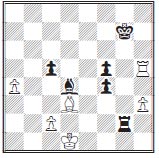
38...c4!
This is a well-timed sacrifi ce in mutual time pressure. Black wants to prevent Rxf5 when White will have no trouble dealing with Black’s f3-pawn.
39.Bxc4
If 39.Bxf5 f3 creates problems.
39...Kg6!
White’s rook is suddenly very uncomfortable.
40.Rh4
Better was 40.Bf7+. Probably Browne did not want to play for a draw after …Kxf7 41.Rxf5+, although Black could try 40…Kf6!? 41.Bd5 Rf2.
40...Be3
Now White has real problems.
41.Bf1?
This loses immediately, but 41.c3 f3 was also difficult.
41...f3! 0–1
David Vigorito 2379
Stephen Brudno 2077
Pillsbury One Day Wonder 1994
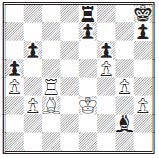
In rook + opposite colored bishop endgames, the initiative is very important. Black should hold this ending, but White manages to create a mating attack. 38.h4 Bd5 39.Rc7 Bxb3 40.g5 Black is grabbing pawns but White has the initiative. 40…Kg8 41.Kf4 fxg5+ 42.hxg5 Bxa4 43.g6 hxg6 44.fxg6 Bc2 45.Kg5 Be4 46.Be5 a4?? Black could hold with 46...b5 47.Rc3 Bxg6 47.Rc4 Rd8 48.Rxe4 Rd5 49.Kf5 a3 50.Ra4 Rd8 51.Rxa3 b5 52.Rh3 Black lost on time. 1–0
David Harris 2072
IM David Vigorito 2519
Blackstone Spring Octads 2010

Here it is my opponent who has the advantage.
32…c3!
The best attempt to create counterplay. When defending, it is usually a good idea to force your opponents to make decisions, as then they are more likely to make a mistake. Here Harris was in serious time pressure of course, and he found it too difficult to deal with all of the options that came his way.
33.Ra7
It was better to take the pawn. After 33.bxc3 f5 34.Bd5 White is still better as both sides have a passed pawn but White’s rook is much more active.
33...Rh4 34.Bg4
Again 34.bxc3 was better.
34...f5!
It is important for Black to activate his rook.
35.Bxf5 Rf4 36.Bd3 e4 37.Bxa6 Rf2!?
This is a risky way to play for a win. I liked that my c-pawn was still alive and fi gured it would cost him a tempo to take it. 37...cxb2+ 38.Kxb2 Rf2 would probably lead to a draw.
38.bxc3 e3
Black is down three pawns now, but he gives the impression that he is creating threats.
39.Kd1?! Rd2+ 40.Ke1
Not 40.Kc1 Ba3+ and mate.
40...Rxc2 41.Be2 Bf6 42.Rc7 Bxc3+ 43.Kd1 Rd2+
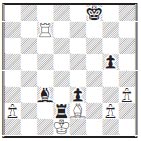
44.Kc1??
Time pressure. After 44.Ke1!= Black does not have any useful discoveries as the bishop is hanging.
44...Bb2+ 45.Kb1 Rxe2 46.Rc2 Rf2!
This is the most accurate and even elicited a comment from my opponent. Black can also win with 46...Rxc2 47.Kxc2 Bd4 48.Kd3 Ke7 49.a4 Kf6 50.a5 Ke5 51.g3 Kf5 52.a6 Ba7 53.Ke2 Ke4 with zugzwang.
47.Kxb2 e2 0–1
Corey Acor 2238
IM David Vigorito 2443
Foxwoods Open 2006
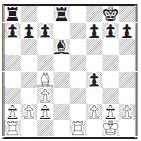
This endgame was played when I was suffering from pneumonia, as it turned out. A couple of rounds later I withdrew and went to the hospital for x-rays. I did not really leave the board for the game. It was 40/2, SD/1 and I used about an hour for the game, while my opponent used almost three.
15.Rad1
My opponent made a draw offer with this move. Despite the fact that I was ailing and had played the Petroff Defense, I decided to play on. Obviously the position is completely equal. However, our doubled pawns are on opposite sides, and I like this type of endgame. I decided there was enough of an imbalance to play on.
15...g6 16.Kf1 Kg7 17.Rd3 h5
It is a typical method for the stronger side in opposite bishop endgame to play the pawns on the opposite color of one’s own bishop. This way the squares of both colors can be infl uenced. The defender, on the other hand, should usually place his pawns on the same color as his own bishop so they will not be vulnerable to attack from the enemy’s bishop. Black is not really any better here, but I was playing optimistically.
18.Red1 Re8 19.Bd5 Rab8 20.c4 b6 21.Bc6 Re7 22.Rb1 Re5 23.Rd5?!
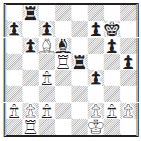
A mistake! Now Black can devalue the white pawns and get a ‘real’ pawn majority.
23...f3! 24.gxf3
Black also has some hope after
24.Rxe5 fxg2+ 25.Kxg2 Bxe5=/+ or 24.g3 Re2 25.Rd3 Rxc2 26.Rxf3 Be5=/+.
24...Rxd5 25.cxd5 Bxh2=/+.
Black has a passed h-pawn, so it’s something. Even though White corrected his pawn structure a bit his majority is easily blockaded on the dark squares.
26.c4 a5 27.Re1 Kf6 28.Kg2
This was a bad decision. After 28.Re8 the rook would go off the board and White would have excellent chances to hold.
28...Be5 29.b3 Rd8 30.Re4 g5 31.Bb5
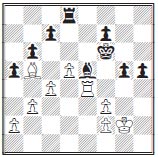
31...Kf5
Opposite colored bishop endgames are about strategy. Here Black intends the long march with f6, Kf5-g6-f7-e7-d6-c5 when White’s queenside will begin to look vulnerable.
32.Bc6 f6 33.Ba4 Kg6 34.Bc6 Kf7 35.Bb5 Ke7 36.f4
This is an interesting decision. White grabs his one chance to mess up Black’s pawns. However, Black still has the passed h-pawn and now he is up a real pawn.
36…gxf4 37.Re1 Kd6 38.Rh1 Rh8 39.Rh3 Kc5 40.a4
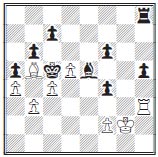
Now the a2-pawn is safe but b3 is vulnerable. Perhaps White thought that his fortress on the queenside would be impossible to breach.
40…Kb4 41.Bd7 h4 42.Be6 Bd6 43.Kf1 Bc5 44.Rd3 Rh5!
Black is ready to activate his rook.
45.Rh3 Bd4 46.Rd3 Be5 47.Rh3 Bc3 48.Rd3 Re5 49.Kg2
The attempt to create counterplay with 49.d6 cxd6 50.Rxd6 runs into 50…f3!
49...Re2 50.Bg4
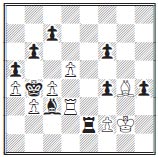
50...Rd2!
I played this instantly. At the time, I found it amusing that Fritz said that this was a blunder and called the ending equal, as it never has any improvements to offer White from now until the end of the game. I would bet that today’s engines fare a little better in assessing the resulting pure opposite bishop ending.
51.Rxd2 Bxd2 52.Bd1 Kc3 53.Kh3 Be1 54.Kxh4 Bxf2+ 55.Kg4 Kd2 56.Bf3 Ke3 57.Bh1 Be1 58.Bg2 Bb4
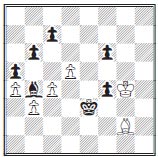
59.Bf1
The extra f-pawn will soon come in handy after 59.Bh1 Bd6 60.Bg2 f3 61.Bf1 (61.Bxf3 f5+) 61...Kf2 62.Bd3 f5+! 63.Kxf5 Ke1
59...f3 60.Kh3 Kf2 61.c5 Bxc5 0–1
Here are a couple of game fragments for study material:
IM David Vigorito 2450
Alessandro Steinfl 2275
National Open 2007
35.Rc4 Ke6 36.e4 Rd8 37.Ke3 Kd6 38.h4 Rd7 39.h5 Ke6 40.Rc5 g6 41.g5 fxg5 42.Rxg5 Kf7 43.Rg1 Rd6 44.Be5 Rd7 45.hxg6+ hxg6 46.Rh1 Ke6 47.Bd4 Rd8 48.Rh6 Rg8 49.f4 Kf7 50.Rh7+ Ke6 51.Bc5 Kf6 52.Be7+ Ke6 53.Bg5 Kd6 54.Kd4 Bd7 55.Be7+ Ke6 56.Bh4 Kd6 57.a5 Bc6 58.Be7+ Ke6 59.Bg5 Bd7 60.Kc5 Rc8+ 61.Kb6 Bc6 62.Re7+ Kd6 63.e5+ Kd5 64.Rg7 Re8 65.Rxg6 Re6 66.Rg8 Ke4 67.Ka7 Bd5 68.Rb8 Bxb3 69.Rxb7 Bc4 70.Rb4 Kd5 71.Bd8 Re8 72.Bc7 Bd3 73.Bd6 Rg8 74.Rb7 Rg1 75.Bb8 Ke6 76.Rb6+ Kd5 77.Rd6+ Kc4 78.e6 Re1 79.Kxa6 Bf5 80.Kb6 Bxe6 81.a6 Bd5 82.a7 Ba8 83.f5 Rf1 84.f6 Rf5 85.Kc7 Kc5 86.Kd7 Rf3 87.Ke7 Re3+ 88.Re6 Rh3 89.f7 Rh7 90.Rf6 Bd5 91.Rf5 1–0
IM David Vigorito 2445
Matthew Goddard 1876
Portsmouth Open 2009
I descended on Parsippany, New Jersey in February for the fourth time in the fi ve years since I moved back to Massachusetts. My team consisted of myself, veteran IM and renowned author Jim Rizzitano, a newly minted Expert, 14 year old Matthew Fishbein of Maine, and Mark Fins, an ‘A” player who frequents both the Metrowest and Boylston chess clubs. Last year I also played with Mark, but we replaced the middle of the lineup this year to form the “Wannabees”.
We ended up with a very decent showing with a 5-1 record, which was good enough for a huge tie for second. Unfortunately our tiebreaks were not so great, and we did not place in the top 5. The top MA team, also with 5-1, went to “The Shmelov Sox”. Denys Shmelov was one of fi ve Board 1 players to go 6-0. Denys beat such players as GM Arthur Bisguier and WGM Rusa Goletiani on the way to his perfect score. This year was unusual because even though the event had record-breaking attendance, there were no teams at 6-0 and only one team with 5.5, the winning “Forking with Tebow’s Knights” led by GM Robert Hess.
We started well enough, going 4-0 against a team of kids who were armed with assorted board-side meals for the match. The most interesting game was played by Jim.
IM James Rizzitano 2390
Jason Shi 1980
USATE 2012 (1)
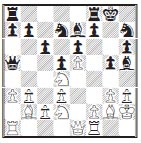
After a Reti (anti-child) Opening, Black has decimated his own kingside with the ridiculous …g5 and stands worse. He decides that it is time for tactics.
15...Nxe5 16.Qxe5 Bf6
Perhaps Black intended 16...Qxd2.
Jim would have been happy to play 17.Qg7+! (17.Nf3 would also win, but mate is better) 17...Kxg7 18.Nf5+ Kg6 (18...Kg8 19.Nxh6#) 19.Nxe7#
17.Qe1 c5 18.Ne4! Qxe1 19.Nxf6+ Nxf6 20.Raxe1 cxd4 21.Bxd4
With the bishop pair and the initiative, Jim had no trouble rolling over his young opponent.
21...Nd7 22.f4 gxf4 23.gxf4 Rac8 24.c4 Bg6 25.cxd5 Nc5 26.dxe6 Nxe6 27.Bf6 Bxd3 28.Rf3 Bf5 29.Rg3+ Kh7 30.Re5 Bb1 31.f5 c5 32.Rg7+ Kh8 33.Re7 1-0
Our second round also proved to be pretty easy, but in the third round the wheels really came off. Mark won easily enough, and Matthew held off his higher rated opponent with the Black pieces. Things were looking good, because Jim had a big advantage against his 2200 opponent, and I was up a piece (!) against a 2300. It looked like we would cruise to a 2.5-1.5 victory or at the worst, draw the match, but Jim gradually let things slip away to a draw and I had a complete meltdown.
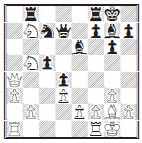
Black is winning a piece, but White has got a couple of pawns at least. First, I have to decide how to take.
21...Qxb5?
In the ending it becomes a little tricky to convert, to say the least. Instead 21...Nxb5 22.Nxc5 Qd6 23.Nxe6 Qxe6 would give Black a close to winning position. The extra piece can be used on the kingside and the opposite colored bishops will help Black to attack. Black can play …Nd6-f5 and …h5. In the middlegame White’s a-pawn is not too scary.
22.Qxb5 Nxb5 23.Nxc5 Bg4

24.h3
I expected this move. White ditches a pawn in order to trap the bishop and look for some tactical chances. I went into this line, thinking that having two pieces against a rook combined with a passed d-pawn would be the clearest way to win. It turns out that matters are not simple at all. It is diffi cult to push the dpawn, and White’s own a-pawn will be very dangerous.
24…Bxe2 25.Rfe1 Rfc8
Black could also play 25...Rfe8, but after 26.a4!? it is not clear how to extricate the bishop.
26.Nd7 Bxd3 27.a4
An interesting move order. Instead 27.Nxb8 Rxb8 28.a4 Nc7 would transpose to the game, but now I started using a lot of time.
27...Nc7
Besides the various knight retreats, there was also 27...Nc3!? to consider. Ultimately it seems that 28.Nxb8 (28.bxc3 Rb2 29.cxd4 Bxd4 -/+) 28...Ne2+ 29.Kh2 Rxb8 30.Bf1 Rxb2 31.a5 is not so clear.
28.Nxb8 Rxb8 29.a5
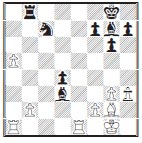
29...Na6
I could feel the confusion setting in. I was well aware I was on my way to botching things, but somehow I could not stop it. White is intending Bg2-f1 to gain control of the a6-square so he can push the a-pawn. This will free Black’s d-pawn too however. The problem was that I could not find a good waiting move. I saw that 29...Bc2 would allow 30.a6 which basically leads to a drawn position after 30…Nxa6 31.Rxa6 d3. Considering I had been up a piece, it was hard to accept this, plus I thought the team would need a win. The obvious move is 29...Rxb2, but I was nervous about leaving that a-pawn with a clear path. I saw 30.Re7 Rc2 31.Bf1 Bxf1 32.Kxf1 and did not like White’s activity, but it turns out that Black can chase the rook with 32…Kf8! 33.Rd7 Ke8 34.Rd6 Ke7 35.Rb6 d3 when Black is still better.
30.Bf1 Bxf1 31.Kxf1 d3
I thought for a long time here too. There is nothing else really, but I had that uncomfortable feeling that I was changing my mind on every move. All of my opponent’s moves were obvious enough and I had not missed anything, but it was all becoming cloudy as I saw little problems here and there.
32.Red1 Bxb2 33.Rab1
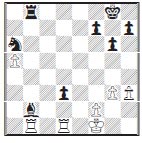
33...Bc3?
By now my clock was very low and I needed to be look for drawing lines. Better was 33...Nc5 34.Rd2 Be5 35.Rxb8+ Bxb8 and strangely enough, White’s rook has no way of bothering the black minor pieces. 34.Rxb8+ Nxb8 35.Rb1! Now things are very diffi cult. I had been hoping for 35.Rxd3 Bxa5 when only Black can be better. Of course my opponent quickly played the move that I feared. At this point I have to pray to get some kind of exchange down ending with all of the pawns on one side of the board.
35...Nc6 36.a6 d2 37.Ke2 h5?
I dreamt of some ending with R vs B when this move would be necessary to stop White’s g3-g4. It will never come to that.
38.Rb8+! Kg7 39.Rc8 Nd4+ 40.Kd1 Nb5 41.Rc5 1-0
A complete disaster. Black loses a piece and does not even get the apawn for it.
IM David Vigorito 2555
David Hua 2299
USATE 2012 (4)
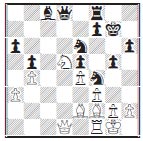
Despite the bishop pair and Black’s slightly weakened kingside, White does not have much. I tried to maintain some tension, hoping for a mistake.
26.Re1! Bb7 27.Nxf4
I played this only after a very long think. Other moves are trickier but ultimately lead nowhere: 27.Bf1 Nxd5 28.exd5 Qxd5 29.Qxd5 Bxd5 30.Rxe5 Bc4! eliminates a White bishop and leaves Black with no problems whatsoever, while 27.Qa1 Bxd5 28.exd5 Qxd5 29.Bxb5!? (with the idea Rxe5) is cute, but after 29…f6 30.Bxa6 Nxg2! gives Black enough counterplay for a perpetual, at least.
27...Nxf4 28.Bf1 Qc7
Black could play 28...Qxd1 29.Rxd1, but White can try a little here too.
29.g3 Ne6
Again White has a chance to play for a bit in the endgame after 29...Rd8 30.Qc1 Qxc1 31.Rxc1 Ne6 32.Be3.
30.Bh3 Rd8 31.Qc1 Qd6 32.Qc3!?
White does not have anything concrete, so I maintain the tension and set a little trap.
32…Rc8?
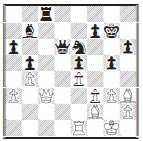
Into which my opponent falls… 32...Nd4 was better.
33.Bc5!+/-
Suddenly White is much better because of the pin on the h3-c8 diagonal.
33…Kf6
I had not considered this daring move, but it is the best try. The queen must defend the e5-pawn, and 33...Qc7 34.Bxe6 fxe6 35.Rd1+/- is terrible. I had mostly been concerned with 33...Nxc5!? but I did not think my opponent would play this as he was in some time pressure. After 34.Bxc8 Na4 35.Qc2 Qd4+ 36.Kf1 Bxc8 37.Qxc8 Qd3+ 38.Kg1 Qd4+ 39.Kh1 (not 39.Kg2 Qd2+ 40.Kf1 Nb2!) 39...Qf2 40.Qc1 Qxf3+ 41.Kg1+/- White is better as the knight is offsides, but there is still some work to do.
34.Bxe6
So we get my favourite kind of opposite colored bishops position. 34.f4? looks fun, but it opens the g-fi le for Black’s rook. 34.Rc1 was good while the computer’s suggestion 34.Kh1!? with the idea of playing f4 is interesting.
34...Qxe6 35.Rd1 Kg6 36.Qb2 f6 37.Rd6 Qe8 38.Qd2 Bc6
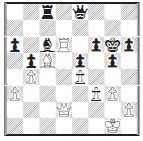
Despite the symmetry of the pawn structure and opposite colored bishops, White is much better because his pieces are so much more active than their counterparts. I was a little low on time here, but my opponent was in serious time pressure.
39.h4
This is logical as it brings another unit into the attack, but there was a quick win with the funny 39.Bb6! with the deadly threat of Bd8+–.
39...Rc7 40.Rd8
Stronger was 40.h5+! Kg7 41.Rxf6!+–. Now my opponent suddenly forgot the clock and lost on time. After 40.Rd8 Qe6 (40...Rd7? 41.h5+ Kg7 42.Rxe8 Rxd2 43.Re7+ Kg8 44.Re6+– is an easy win) 41.Rd6 Qf7 (41...Qb3? loses immediately to 42.Rxf6+, while 41...Qe8 would give me a chance to transpose to now fi nd 42.h5+ , now that the time control was reached) and now White can still probably win, but it is complicated. Some lines: 42.Qc3! (with the idea Qxe5) 42...Qe7 (42...Qe8 43.Bb6! Rc8 44.Qd2 with the idea Bd8+–) 43.hxg5 hxg5 44.f4! exf4 (44...gxf4 45.Qf3!) 45.e5 Qh7 46.Qc2+ Kh5 47.Qe2+ (47.Qxh7+ Rxh7 48.Rxc6) 47...Kg6 (47...f3 48.Qh2+ Kg6 49.Rxf6+ Kg7 50.Qxh7+ Kxh7 51.e6+–) 48.Rxf6+ Kg7 49.Bf8+ Kg8 50.Qa2+ Rf7 51.Bh6 Be8 52.gxf4+– 1–0
After another team win in Round 5, the stage was set – literally, as we had fi nally made it back to the roped off area. We ended up paired with another MA team, the 2199 rated “Overrated” led by Vadim Martirosov and Ilya Krasik. Vadim and Ilya were my teammates in my return to the USATE back in 2007. We lost on Board 4, but held on Board 3, and Jim and I both managed to win.
Ilya Krasik 2295
IM James Rizzitano 2390
USATE 2012 (6)
Despite having the Black pieces, Jim quickly was in control of his game and won a pawn early. He only needed to coordinate his pieces to win. The e7-knight is Black’s only real problem.
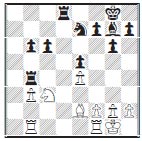
21...Rd2 22.Bd1 b5 23.Ra1 Rbd4 24.Ra8+
This helps Black implement his plan, but there is not much to suggest to White.
24…Bf8 25.Bf3 Kg7 26.h3 R4d3 27.Rc1 Rb2 28.Bd1 Rdd2 29.Ne2
29...Ng8!
The knight quickly enters the game from its home square and Black wins quickly.
30.Kf1 Nf6 31.f3 Nh5 32.Ke1 Bb4 0–1
So we ended up with a 5-1 score. Jim, Matthew, and I also scored 5-1. For Jim and I, this was not as nice as it seemed, as he only gained a couple of rating points, and I even lost a couple. Matthew had a great tournament – his fi rst USATE. Mark went 3.5-2.5, but he mostly played up and also gained a few points. The tournament was great fun as usual. This is a tournament where you can catch up with lots of friends along the east coast, and the team atmosphere and camaraderie make it unlike any other event.
|